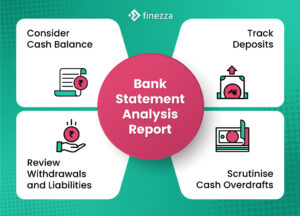The lending process comes with some inherent risks; there is always a likelihood that the borrower may default on payments or delay paying instalments. So, lenders typically employ a combination of tools and strategies to manage and reduce the risk associated with lending. A bank statement analysis tool is one such solution that helps them manage their credit risk. A bank statement analysis report provides a comprehensive insight into the applicant’s financial health.
The analysis helps the lender assess the borrower’s creditworthiness, and these reports play a crucial role in streamlining the lending process by identifying any red flags and ultimately making informed decisions.
The discussion below focuses on how these reports help streamline the lending process.
How Can Bank Statement Analysis Report Help Lenders Streamline The Lending Process?

A bank statement gives a periodic view of all an individual’s transactions, including deposits, withdrawals, transfers, interest earned, bank fees, EMIs, and other transactions. In this context, a bank statement analysis report offers crucial insights to lenders, businesses, and individuals. It can help lenders assess the applicant’s financial stability and streamline the lending process by evaluating the following aspects.
1. Consider The Cash Balance
The first thing lenders need to consider when assessing a loan applicant is to look at the cash balance in an applicant’s bank account. A positive cash balance indicates the applicant can manage their cash flows effectively and will be able to pay their EMIs on time, making them a desirable candidate.
Negative cash balances are a red flag, and the lender would view such applicants unfavourably. The level of cash balance considered ideal for getting a loan approval depends on the loan amount the applicant is applying for; the larger the loan application amount, the higher the cash level they should maintain.
2. Track Deposits
A crucial aspect of the bank statement analysis report is monitoring the deposits. A regular inflow in the account indicates a steady source of income and points towards the borrower’s ability to repay the instalments on time.
Looking at the bank statement, the lender can verify if a salaried employee or a business owner is getting regular and sufficient inflows to pay their loan dues.
Irregular or substantial deposits are a matter of concern, and the lender may want to exercise caution, ask for an explanation or consider additional documents before approving the loan.
3. Review Withdrawals and Liabilities
Monitoring withdrawals from the bank account is an integral part of the bank statement analysis report. Looking at the bank statement can help lenders identify if there are any undisclosed loans; regular withdrawals of the same amount are suggestive of a loan EMI.
Bank statements also provide insights into other liabilities that an applicant has that must be paid, like monthly rent, fees, or staff salaries. Lenders consider withdrawals made from the account to assess an applicant’s ability to repay a loan accurately.
4. Scrutinise Cash Overdrafts
Banks sometimes offer cash overdraft facilities to account holders that allow them to withdraw more than the amount available in their account.
Examining a borrower’s bank statement helps lenders identify any instances of overdrafts and understand the borrower’s financial management skills. Frequent overdrafts indicate the applicant struggles to manage their cash flows effectively and may find it difficult to pay their EMIs regularly.
What Are The Benefits of the Bank Statement Analysis Report?
Bank statement analysis reports help financial institutions streamline their operations; they offer a host of other benefits. Below, we discuss four benefits offered by bank statement analysis.
1. Decision-Making Is Faster
Automating bank statement analysis helps in faster extraction and categorisation of data. Leveraging artificial intelligence helps analyse massive volumes of data effortlessly without any manual intervention.
AI algorithms extract essential data in minutes, provide actionable inputs and eliminate the need for manual review. Lenders can assess a borrower’s income, expenses and other key financial indicators, leading to faster loan approvals without compromising the accuracy.
2. More Accurate Assessments
An automated bank statement analysis report eliminates the errors and inconsistencies associated with conventional ways of assessing a borrower’s application. Traditionally, lenders only focused on credit reports, which do not provide a holistic perspective of the borrower’s financial situation.
Analysis of bank statements offers lenders a comprehensive view of a borrower’s financial activity and can help identify discrepancies in the applicant’s credit report. This assists lenders in making a more accurate assessment of the applicant’s financial health.
3. Documentation Process Gets Streamlined
When applying for a loan, applicants often have to submit multiple documents, making the process tedious. Bank statement analysis helps deal with this problem as lenders can get details about the borrower’s income, employment status, and other financial information directly from the bank statement.
Borrowers are not required to submit multiple additional documents like employment records and tax records, as the statements already have this information. Bank statement analysis reports can help lenders avoid asking applicants for duplicate documentation, helping them streamline and reduce the loan documentation process.
4. Risk Assessment Improves
Lenders get a deeper and more exhaustive understanding of the borrower’s spending patterns and financial health with the help of the bank statement analysis report.
Analysing bank statements can help identify risks that may not be apparent from other sources. Unusual spending patterns and large cash withdrawals can flag concerns and help lenders make a more accurate assessment about accepting a loan application.
The Bank Statement Analyzer from Precisa extracts data from the bank statement, classifies and categorises transactions, analyses the data, detects fraudulent transactions and other anomalies, and assigns an overall creditworthiness score called Precisa score to help lenders in decision-making.
To Sum It Up
Banks Statement Analysis Reports are a valuable tool to help lenders make more informed and accurate lending decisions. These reports can help lenders manage their risk better by determining the applicant’s ability to pay loan instalments regularly and identify any potential red flags.
Analysing bank statements manually can be daunting due to the time involved and the inherent risk of making mistakes. The web-based Bank Statement Analyzer from Precisa helps lenders deal with these challenges by reducing the processing time by 5X and improving productivity by 8X.
Request a free demo today!




Leave a Reply